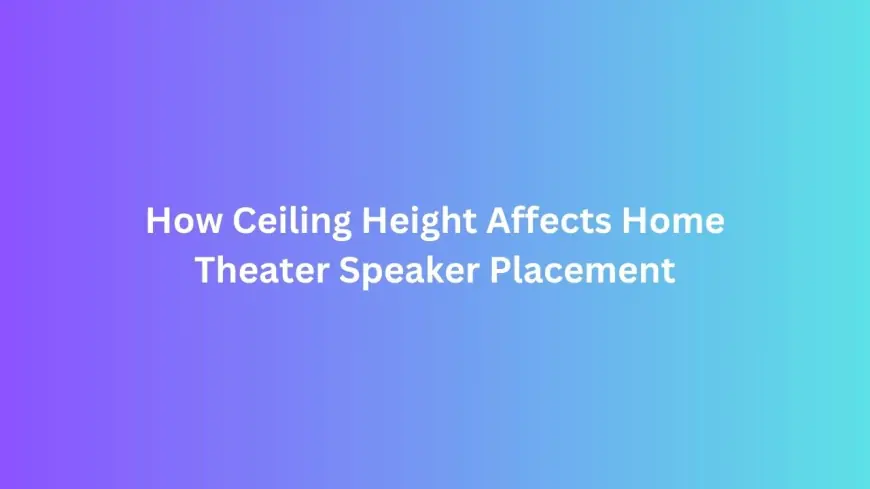How Ceiling Height Affects Home Theater Speaker Placement
In this blog, we’ll explain the physics behind ceiling height, the challenges and opportunities it presents, and how to adapt your speaker placement for optimal sound in any room.

When designing a home theater setup, many people focus on speaker brands, subwoofer power, or screen size. However, one often-overlooked element plays a crucial role in the sound quality and experience: ceiling height. Whether your room has low ceilings, standard 8-foot ceilings, or a tall vaulted ceiling, this vertical dimension can greatly influence how sound travels, reflects, and immerses the audience. Understanding how ceiling height affects home theater speaker placement is essential for getting the best possible audio performance from your setup.
In this blog, we’ll explain the physics behind ceiling height, the challenges and opportunities it presents, and how to adapt your speaker placement for optimal sound in any room.
Why Ceiling Height Matters in a Home Theater
Sound waves move in all directions. While horizontal space is often prioritized for speaker spacing, vertical space determines how sound reflects and disperses throughout the room. A ceiling that is too low can compress sound and limit upward dispersion, while a high ceiling may cause sound to scatter, weaken, or echo.
Ceiling height affects:
-
Speaker mounting height
-
Sound reflections and absorption
-
The placement and angle of surround and height speakers
-
Bass performance and reverb timing
-
Acoustic treatment requirements
Let’s look at how different ceiling heights impact home theater speaker placement and how you can adjust accordingly.
Low Ceilings (7 to 8 Feet)
Rooms with low ceilings are common in basements, apartments, or older homes. In these setups, vertical space is limited, which can make speaker placement more challenging.
Challenges:
-
Limited height for mounting wall or surround speakers
-
Less room for sound to expand vertically
-
Potential for early ceiling reflections that interfere with direct sound
-
Difficulty in placing Dolby Atmos overhead speakers
Solutions:
-
Mount speakers slightly above ear level, rather than far above, to reduce ceiling reflections.
-
Use on-wall or bookshelf speakers instead of tall floor-standing ones.
-
Avoid upward-firing Atmos modules in extremely low rooms—they won’t have space to reflect sound effectively.
-
Consider using in-ceiling Atmos speakers positioned directly above the listening area if you still want height effects.
-
Add acoustic panels to the ceiling to absorb first reflections and reduce harsh echoes.
In low-ceiling rooms, precision is key. Keep speaker angles tight and aim for minimal vertical bouncing.
Standard Ceilings (8 to 9 Feet)
Standard ceiling heights offer enough room for most home theater configurations without requiring major design compromises.
Benefits:
-
Sufficient vertical space for proper surround and front speaker angling
-
Adequate room for ceiling-mounted Atmos speakers or upward-firing modules
-
Balanced sound reflections with minimal echo or diffusion issues
Best Practices:
-
Place front left and right speakers at ear level, or slightly above, angled toward the listener.
-
Mount surround speakers 1 to 2 feet above ear level for a balanced ambient effect.
-
For Dolby Atmos, use upward-firing speakers placed atop your front and rear channels—they’ll have enough space to reflect off the ceiling and create convincing height effects.
-
If installing in-ceiling speakers, place them at least 3 feet in front of and behind the primary seating zone, aimed toward the center.
Standard ceilings allow the most flexibility for experimenting with positioning and speaker types.
High or Vaulted Ceilings (10 Feet or More)
While tall ceilings look impressive and create a feeling of spaciousness, they pose unique acoustic challenges for sound control and speaker placement.
Challenges:
-
Delayed ceiling reflections can cause echo or reduce clarity
-
Sound may “float away” instead of feeling grounded
-
Dolby Atmos upward-firing speakers become ineffective
-
Bass may sound less tight or focused due to larger air volume
Solutions:
-
Avoid upward-firing Atmos modules—use in-ceiling speakers or downward-firing height speakers mounted on the ceiling.
-
Add acoustic clouds or ceiling-mounted diffusers to reduce echo and control reflections.
-
Use taller speaker stands or adjustable mounts to position speakers closer to ear height.
-
For surround channels, consider mounting them at mid-wall height instead of near the ceiling to avoid excessive diffusion.
-
Calibrate your system carefully, adjusting speaker levels and distances to account for sound dispersion loss in the vertical plane.
In high-ceiling rooms, taming the vertical acoustics becomes just as important as horizontal speaker placement.
Ceiling Height and Dolby Atmos
Dolby Atmos has specific ceiling height recommendations because the height layer of sound depends on accurate reflection or overhead output.
-
Minimum recommended ceiling height for upward-firing Atmos modules is 7.5 feet
-
Ideal ceiling height is 8 to 10 feet with a flat, reflective surface
-
Ceilings that are too high or vaulted should use direct in-ceiling Atmos speakers instead of modules
If your ceiling is uneven or made of absorptive material like popcorn texture or wood panels, upward-firing speakers won’t reflect sound properly. In such cases, ceiling-mounted speakers with directional aim are a better option.
Adjusting Home Theater Speaker Placement Based on Ceiling Height
No matter your ceiling height, here are general tips to maintain proper home theater speaker placement:
-
Front left and right speakers: Position them at ear level and angle them inward slightly toward the listener.
-
Center speaker: Directly below or above the screen, angled toward ear level.
-
Surround speakers: Mount them at 90 to 110 degrees relative to the listening position, about 1 to 2 feet above ear level.
-
Subwoofer: Ceiling height affects bass resonance, so experiment with placement—especially in tall rooms where bass can become boomy.
-
Height speakers: Use the right type for your ceiling—modules for flat, low ceilings; in-ceiling or angled for tall ceilings.
Final Thoughts
Ceiling height is more than just an architectural detail—it’s a key factor in how sound behaves in your room. From limiting the effectiveness of height channels in low spaces to causing echoes in high ones, ceiling height directly influences your audio performance and design choices.
By adapting your home theater speaker placement to the ceiling conditions in your room, you can overcome challenges and unlock immersive, balanced sound. Whether you’re setting up a compact media room or a grand cinematic space with soaring ceilings, understanding vertical acoustics is your first step toward building the ultimate home theater experience.
Read more: https://newyorktimesnow.com/blog/seasonal-speaker-placement--adjusting-for-holiday-or-party-layouts
What's Your Reaction?
 Like
0
Like
0
 Dislike
0
Dislike
0
 Love
0
Love
0
 Funny
0
Funny
0
 Angry
0
Angry
0
 Sad
0
Sad
0
 Wow
0
Wow
0


















































